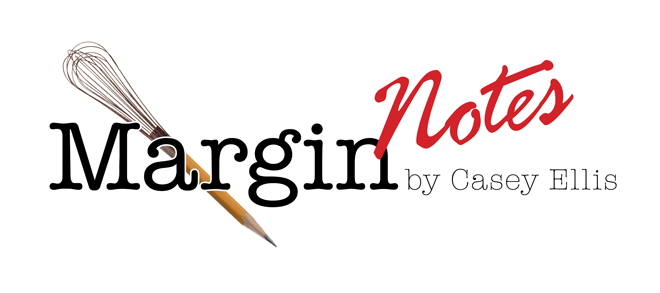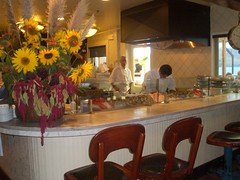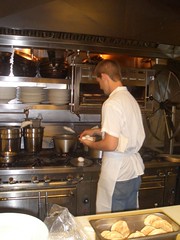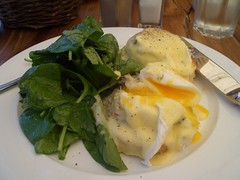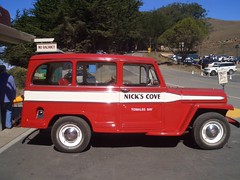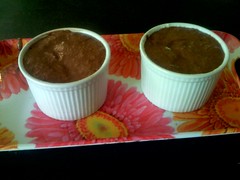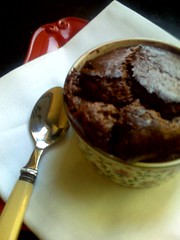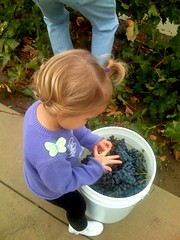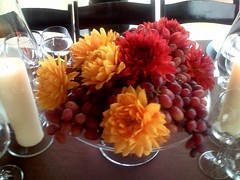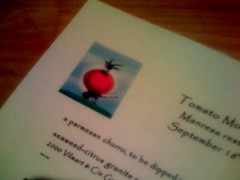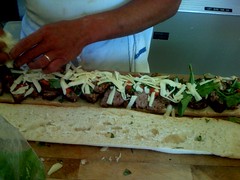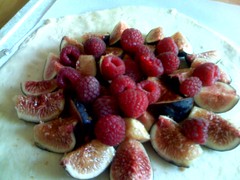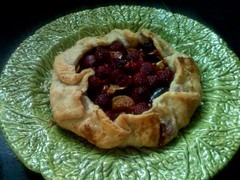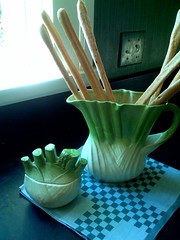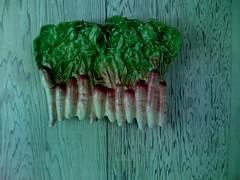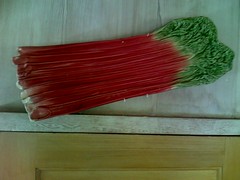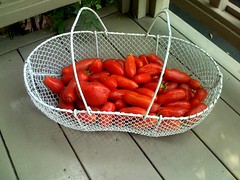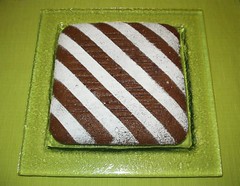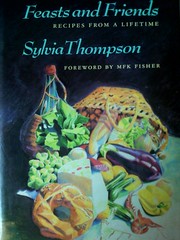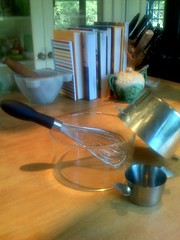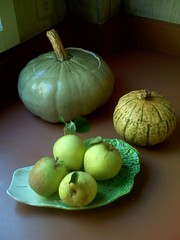Sunday, September 30, 2007
Pat is in the Details
The fish tacos I had for dinner Friday night at Nick's Cove on Tomales Bay were so good I was tempted to order them again Sunday morning at brunch, but the "you must be kidding" look I got from across the table made me pick eggs Benedict instead. Thus bullied into choosing conventional breakfast fare, I skulked off to the open kitchen to watch the cooks.
"Do you make your own hollandaise sauce," I asked, realizing the absurdity of the question as soon as it left my lips. Every head in the kitchen snapped around as if jerked -- hard-- by invisible cords. I had just won "Stupidest Customer Inquiry of The Week." Bottled hollandaise sauce in a Pat Kuleto kitchen? Not very damned likely.
"These just came out of the oven 10 minutes ago," an adorably baby-faced cook said, holding up a pan of big, flaky biscuits that would take the place of the more common English muffins. Then he turned back to the cooktop and cracked eggs into the poaching water, and I scurried back to my seat, knowing that those eggs would soon be headed my way.
Less than five minutes later the eggs you see in the photo were placed in front of me. What you can't see is that nestled between the Hollandaise-swathed egg and the meltingly tender biscuit is a mound of sweet fresh crabmeat.
And look at the color of the egg yolk. The flavor of truly fresh eggs is so splendid it makes you want to swear off supermarket eggs forever. Quite simply, these were the best eggs Benedict I've ever eaten. And a reminder that even the simplest dishes can be supremely satisfying when attention is paid to each component detail.
(Of course, sitting on a porch alongside Tomales Bay, with sun sparkling on the water and kayaks gliding by, makes any meal more memorable, but I've had many a mediocre meal at restaurants with great views.)
Is is so much to ask that someone at Nick's deliver me an occasional meal in this little red truck? I live a mere two hours away.
Posted by
Casey
at
9:04 PM
9
comments
![]()
Labels: Nick's Cove, Pat Kuleto
Wednesday, September 26, 2007
You Say "Flatbread;" Soif Says "Farinata"

No matter how many "small plates" I order at Soif, I always include the farinata -- the luscious little chick-pea flour lovechild of a crepe and a pizza crust. Similar to a French socca, it's cooked to order and arrives at the table piping-hot. Usually perfumed with fresh sage, last Sunday's version sported fresh basil. And olives. And every bite made me want to moan with delight.
I adore Soif, a Santa Cruz wine bar and restaurant with a kitchen directed by the talented Chris Avila, whose food at La Posta I raved about in an earlier post. Soif's menu changes frequently, although a few dishes are nearly always available: crostini with pumpkinseed chevre and pomegranate molasses, boquerones atop perfect aioli, piquilla peppers stuffed with manchego cheese and sublime little lamb meatballs with almond sauce. (According to our waitress one evening, the lamb meatballs get a major flavor boost from caramelized onions incorporated into the mix.)
Most farinata recipes I've researched call for a combination of broiling and baking the batter, but I've come closer to replicating Soif's version by starting the batter stove-top, in a well-heated crepe pan, and then finishing it under a hot, hot broiler.
(Margin note: When I asked one of Soif's cooks for advice, he stressed the importance of letting the batter rest for several hours before cooking it.)
Farinata con Salvia (Chick-Pea Flatbread with Sage)
(adapted from a recipe from Gourmet Magazine)
2 cups chick-pea flour
1 1/2 cups cold water
2 teaspoons salt
1/3 cup olive oil
Fresh sage leaves
Coarsely ground pepper
Gradually whisk flour into water. Whisk in salt and oil. Let batter stand, covered, at least two hours, preferably three.
Now, at this point Gourmet instructs you to pre-heat the broiler and set the oven rack about 5-inches from the heat. Oil a 13- by 9-inch flame-proof baking pan (preferably with olive oil) Stir batter and pour into pan. Tear sage leaves into bits and sprinkle sage and pepper over the battter. Broil farinata 5 minutes or until top is speckled with brown spots. Reduce temp. to 450-degrees and bake farinata 5 minutes more, or until set and pulling away slightly from pan sides. Cut into squares and serve immediately. Serves 6 as a snack or accompaniment.
OK, that's the safe and tested-in-Gourmet's-rigourous-kitchen approach. Mine is a tad different -- and a lot less precise. But I like the looks of mine better.
I, too, get the broiler very hot--although I haven't measured how far my top oven rack is from the heating element. Next I heat a six-inch crepe pan, add olive oil and heat til the oil almost smokes. Then I pour in enough batter to make a pancake about a quarter-inch thick, toss on the herb leaves and, occasionally, some cooked veggies.(At Soif the farinata often sports caramelized onions.) After a minute or two, I peek at the underside. If it's well-browned, I stick the pan under the hot broiler until the top has plenty of dark spots. I tip the crepe onto a warm plate and then repeat with more batter. Then I yell at people to eat them RIGHT NOW WHILE THEY'RE HOT, although I tend to mumble because I'm already eating a piece myself.
You can find out more about Soif on its gorgeous website: www.soifwine.com
Posted by
Casey
at
9:18 PM
4
comments
![]()
Monday, September 24, 2007
Souffle Tuesday: Chocolate Challenges
Those tidy little dishes in the first picture? They're the "Before." No way are you seeing the "After." Suffice it to say that my previous proclamation about always filling souffle dishes to the rim should be ignored with this recipe -- unless of course you want to make them for a luau and label them "Oozing, Half-burnt Chocolate Lava Mounds."
Actually, the parts that managed to stay in the dishes were quite tasty, but the overall appearance: UGLY.
However, one of the reasons I wanted to try this recipe was the headnote promising the uncooked souffles could be frozen and then baked straight from the freezer. So, two ramekins went into the oven and the rest were wrapped tight and frozen. First, the recipe:
Do-Ahead Chocolate Souffle
(from Cooking Light Magazine)
butter (instead of the cooking spray suggested by C.L.)
1/2 cup plus 2 tablespoons sugar, divided
3 tablespoons all-purpose flour
3 tablespoons unsweetened cocoa
1/8 teaspoon salt
1 1/4 cups fat-free milk
3 ounces bittersweet chocolate, chopped
1 teaspoon vanilla extract
1 large egg yolk
6 large egg whites
Preheat oven to 425-degrees.
Generously butter the interiors of 6 (8-ounce) souffle dishes. Sprinkle with the 2 tablesppons sugar. Set in refrigerator.
Combine remaining 1/2 cup sugar, flour, cocoa and salt in a saucepan over medium heat, stirring with a whisk.
Gradually add the milk, stirring constantly with a whisk, and bring to a boil. Cook 2 minutes or until slightly thick, whisking constantly. Remove from heat. Add the chopped chocolate and stir until smooth. Transfer mixture to a large bowl; cool to room temperature and then stir in the vanilla and the egg yolk.
Beat the egg whites util soft peaks form. Stir in 1/4 of the egg whites into the chocolate mixture and then fold in the remainder..
Spoon mixture into prepared dishes; place on a baking sheet and put on lowest shelf of the pre-heated oven. Immediately reduce oven temperature to 350-degrees. Cook for about 35 minutes or until a wooden pick inserted in the side of a souffle comes out clean.
Two days after the flowing-over-the-rim-and-baking-solidly-onto-the-ramekin-sides episode, I pulled one of the frozen souffles from the freezer, scraped some of the frozen batter from around the inside edge of the dish, baked it about 5 minutes longer than the unfrozen ones and had a far happier result. Witness Photo #2. Now if I could just remember to set out the camera before I take a souffle from the oven I might actually get a picture at full poof.
Posted by
Casey
at
8:08 PM
7
comments
![]()
Sunday, September 23, 2007
Under the Saratoga Moon
Before dinner, some of the guests actually picked grapes. Seeing this little cutie pick a few, eat a few, pick a few, eat a few was the best kind of pre-dinner entertainment. As the sun set, we sat at long tables on an outside terrace and dined on the splendid fare of San Francisco caterer Paula LeDuc. (When I know I'm going to be eating a dinner prepared by LeDuc's crew my mouth starts watering about breakfast time.)
The Tuscan-style dinner began with passed platters of calamari salad, marinated cauliflower and heirloom tomatoes with mozzarella. Next came moist cod, followed by platters of the spit-roasted pork. A trio of chocolate desserts completed the meal -- although some of us wandered over to an outdoor fire pit where ingredients for s'mores were laid out -- including incredibly delicious home-made marshmallows. An American classic proved the perfect ending for a meal inspired by Italy.
Posted by
Casey
at
2:19 PM
2
comments
![]()
Friday, September 21, 2007
Manresa Does Tomatoes, continued:
I always harbor a little guilt when I eat bunny, but the next course -- a rabbit daube with basil surrounded by a tomato vinaigrette and garnishes of new zealand spinach -- was so good that I banished mental pictures of Peter Rabbit and Thumper. The following dish was the only one I didn't love:a deconstucted "ratatouille" and sheep's milk rictotta with sheep's milk as a sauce. The ingredients were impeccably fresh and certainly each was delicious; I just didn't see the scattering of ingredients across the plate as "ratatouille" -- even with the qualifying quotation marks.
Following this slight disappointment, came a suprise course that at first rang my HO-HUM bell: three tomato wedges -- a red, a yellow and a pink-- drizzled with olive oil and sprinkled with salt. OMG, it was fabulous. The olive oil was French; the salt was seaweed based and the combination with the tomatoes had us hailing the bus boy for yet more bread. Not a one of our plates went back to the kitchen with a drop of olive oil or tomato essence remaining.
And the food kept coming.
Roast duck and foie gras with caponata was simply magnificent, as was the dessert: caramelized brioche and a slow confiture of tomatoes plus vanilla olive oil ice cream. (Our friend, a sophistacted and long-time owner of numerous restaurants, was softly chanting "More brioche; more brioche")
Lovely LeRoy wines throughout the meal, exquisite Numi teas at the end and Manresa's marvelous little black olive madeleines: What's not to LOVE?
Posted by
Casey
at
9:40 AM
5
comments
![]()
Labels: Manresa
Wednesday, September 19, 2007
Tomatoes Triumphant: A Special Dinner at Manresa
But let's get a disclaimer up here: Resident Gardener and I are investors in Manresa -- as are numerous other devotees of Kinch's food since his days at Sent Sovi. I don't write for newspapers or magazines about Manresa or Kinch, but here, well: it's my own space and I'll blog if I want to. And if these Tomato Feast posts send any of you running to Manresa it'll probably mean all of another 27 cents in our next investor's return check.
Back to the tomatoes:
We began with parmesan churros, served with an anchovy-tomato "hot bath" for dipping. I could have eaten a basketful. Next came a seaweed-citrus granite with a crisp little nori cracker --all atop "corn and tomato vers.4.2." [Another day I'll blog about "corn and tomatoes vers.1.1" - a Kinch dish friends and I are still talking about a mere 11 years after we first ate it.}
Following those savory little amuse-bouches we had "a delicate gel of tomato and ripe melon, a tisane of herbs and flowers flavoring crab and shellfish, and golden raspberies" which was a lovely lead-in to an absolutely sensational plate of
assorted cherry tomatoes with steelhead roe (cured in oak smoked salt) surrounded with roast tuna juice and a sprig of purslane.
I took one bite of the cherry tomatoes, turned to Resident Gardener and said: "Do not think that just because this is so good it's going to inspire me to PEEL CHERRY TOMATOES." An elegant touch, though.
The next course was one of my favorites of the night: fresh Monterey Bay spot prawns, cooked on the plancha, "perfumed with a rare virgin argan oil," and accompanied by tomato slices with beets and rucula sylvetta. I don't even *like* beets. Hell, usually I hate the little buggers. But in this dish they were wonderful. And the prawns were sublime. David told us they were split in half while still alive and then set on the hot plancha for a mere 10 seconds. Much more heat than that, apparently, can turn the delicate flesh to mush.
Thus endeth the first half of the meal. To be continued...
Posted by
Casey
at
10:57 PM
2
comments
![]()
Labels: David Kinch, Love Apple Farm, Manresa
Monday, September 17, 2007
Souffle Tuesday: Lemon Souffle Gratineed
I know. I know. This photo is DARK, but I wasn't about to mar the candle-lit Friday night ambience at Bistro Elan with a camera flash. Yet this little souffle was so amazing, I had to capture its image.
Fresh huckleberries were nestled between two layers of lemon souffle and then a crackly creme-brulee-like topping finished off the dish. To discover how the topping was accomplished I'm going to have to sit at the counter of Bistro Elan's open kitchen and quiz the pastry chef. Until I do, I'm at least going to experiment with layering some berries in a dessert souffle. Perhaps raspberries in a vanilla base. Or diced super-ripe plucots between layers of strawberry souffle.
And when I discover the topping technique I suspect I'm going to have to buy a blowtorch.
Posted by
Casey
at
10:02 PM
9
comments
![]()
Sunday, September 16, 2007
Mmmm: Meatball Sandwich
No, I did NOT eat this entire sandwich. but I could have. The piece I *did* consume could serve as a Platonic ideal for sandwiches -- moist meat, sauteed onions, fresh basil, roasted red pepper sauce, provolone cheese and arugula. The layers of flavor and freshness of ingredients were typical of the splendid sandwiches available each day at Carried Away in Aptos, California.
Owners Tom McNary and Mima Lecocq met while working at Chez Panisse, which immediately tells you a lot about the philosophy underlying the fare at this sophisticated little take-out shop.
The soups are just as good as the sandwiches; the entrees are imaginative and delicious, the cookies addictive and the pizza my favorite in the Bay Area.
One weekend we served Tom's Gorgonzola, roasted red onion and walnuts pizza to houseguests for Saturday lunch. On Sunday morning our chums told us they had to leave early because of pressing chores at home. Their bags were packed and standing by the door when one of them asked, "By any chance is there some of that pizza left? And if there is, were you planning to serve it for lunch?"
When I replied that it indeed would be on the lunch menu, they suddenly decided they didn't need to depart quite as quickly as they'd thought. After lunch would be fine.
The moral of this story: Only serve Carried Away's food to houseguests you want to linger.
If you can't get to Aptos you can find some of Carried Away's recipes on their website: wwww.carriedawayfoods.com.
Posted by
Casey
at
5:06 PM
5
comments
![]()
Friday, September 14, 2007
Almost-Autumn Galette
All this required was the defrosting of a little round of pate brisee from my freezer, a quick quartering of figs, a scattering of raspberries on top, a sprinkling of sugar (this time I used brown) and some dabs of butter. Pleating the edges of a pastry round to make an open-faced galette is one of baking's pleasanter little tasks.
Almost as pleasant as eating the galette -- still fragrant and warm from the oven. I served creme fraiche with a bit of brown sugar sprinkled on the top alongside. Softly whipped cream or a dab of ice cream would have worked equally well.
I adore fruit galettes.
And I hate squirrels.
Posted by
Casey
at
3:26 PM
4
comments
![]()
Labels: raspberry fig galette
Thursday, September 13, 2007
Mad about Majolica
I have this tiny little food-related addiction, aka a passion for pottery. To me, sliced tomatoes look more delicious when served on a green majolica platter, madeleines more evocative of France when piled onto a Quimper plate, even olives more appealing in a little terra cotta tapas dish.
Amongst my favorite pieces are the fruit and vegetable inspired creations of Rhode Island potter Barbara Eigen, particularly her signed work from the 70s and 80s.
Here her fennel pitcher holds breadsticks and the little fennel-heart dish contains a roasted red pepper dip.
The driftwood-grey walls of my beach house kitchen work well (she said, modestly) with the majolica's matte finishes. Here a much-loved radish platter hangs near a similarly-sized row of Eigen-depicted asparagus. I know she produced corn cob platters around the same time, and although I haven't been able to locate one yet, I SHALL.
The rhubarb platter is huge, more than twice the size of the radish cluster and has a ditinguished provenance. For years it resided in the kitchen of baker extraordinaire Flo Braker -- San Francisco Chronicle columnist and author of outstanding baking books. (I cannot imagine anyone who cares even minimally about pastry-making not owning Flo's "The Simple Art of Perfect Baking.")
Every time I entered Flo's kitchen I would glance at this platter and remind her that I expected it to be left to me in her will. One day we were to meet for lunch at an elegant restaurant. I was already seated when Flo walked through the dining room with this big chunk of pottery tucked beneath her arm. She plunked it down in front of me and said, "Now please stop hoping I'll die."
I've treasured it ever since and feel sure Flo now will live to at least 110.
Posted by
Casey
at
11:00 AM
17
comments
![]()
Labels: Barbara Eigen, Flo Braker, majolica
Monday, September 10, 2007
Souffle Tuesday: How Not to Write a Recipe
Seduced by a gorgeous photo in "Gourmet's Menu Cookbook" and my immoderate affection for leeks, I decided to make the book's hazelnut and leek souffle. I quickly discovered that the actual recipe was ridiculously vague about the main ingredient: "Chop finely 10 trimmed leeks (let's not even go into the grammatically incorrect "finely" for "fine")and 1 onion" --uh, this is not a soup or a stew, this is baking and baking requires at least a nod in the direction of precise measurements.
What size leeks? Pencil-thin? Fat as billy-clubs? And what size onion? Maddening.
To deal with this I turned to the basic Julis Child souffle formula I posted last Tuesday, fiddled a bit with other parts of the recipe and settled on this:
Leek and Hazelnut Souffle
inspired by a recipe from "Gourmet's Menu Cookbook."
Butter a 6-cup souffle dish and coat bottom and sides with grated Parmesan cheese. Place dish in refrigerator and pre-heat oven to 400-degrees.
Chop fine enough leeks to measure 2/3 cup and simmer them in 1 cup milk for about 5 minutes, drain the leeks, reserving the milk. Make a thick white sauce with 2 1/2 tablespoons butter, 3 tablespoons flour and the reserved milk.
Remove from the heat and stir in 4 beaten egg yolks. Fold in the leeks, 1/3 cup chopped hazelnuts and 3 tablespoons grated Parmesan, 1 tablspoon minced parsley and salt and pepper to taste. (Remember that the seasoning's intensity will be diminished by the egg whites)
Beat 5 egg whites until they start to foam; add 1 teaspoon of salt and continue beating until soft peaks form. Stir 1/4 of the whites into the base mixture and then fold in the rest. Gently spoon into the prepared dish and place in pre-heated oven. Immediately reduce the heat to 375-degrees. Bake until golden brown and no longer wiggly.
Not the prettiest souffle --the interior is rather drearily beige--but delicious. I made a sort of a sauce for it by melting some unsalted butter and stirring in a generous amount of minced chives. Chive blossoms would have been even prettier, but our garden has fallen behind on its chive flower production.
Posted by
Casey
at
8:05 PM
4
comments
![]()
Sunday, September 9, 2007
Tomato Tasks
So this is how I spent most of my Sunday afternoon: cutting plum tomatoes in half, scooping out their gooey ribs and seeds with my fingers and roasting the hell out of them. All the tomatoes in this basket came from one ridiculously fecund plant, a fecundity I rather resented about half-way through the slicing and scooping. But, come winter, when I pull a little package of these intensely flavored morsels out of the freezer and toss them with some pasta or lay a tomato-y ribbon across a sauteed chicken breast, I'll be glad I did the Ma-Ingalls-preserves-crops-for-Winter bit. Even though I really just wanted to lie on the couch re-reading a Donna Leon mystery.
Oven-charred Plum Tomatoes
Don't use this method for any but ripe-yet-still-firm plum tomatoes; most other types just cook down into a soupy mess.
Line a baking sheet with aluminum foil and brush with olive oil.
Cut tomatoes in half length-wise and remove the ribs and seeds. Place on the pan cut-side up. Sprinkle gernerously with salt and dizzle with olive oil. Place in a 425-degree oven and roast until shriveled and charred black along the edges. This usually takes a little over an hour in my experience, but YTMV.
After about 45 minutes, toss in some whole cloves of peeled garlic and check to see if a few of the smaller tomato halves need to depart the oven earlier than their bigger brethren.
When fully roasted, remove from oven, cool and store in small, freezer-friendly containers. I usually put one container in the fridge and freeze the rest.
Posted by
Casey
at
1:39 PM
5
comments
![]()
Friday, September 7, 2007
An Artist Bakes the Ginger Cake
I don't have an artistic molecule in my body but I'm a great appreciator. My friend Stella -- with whom God was generous with artistic gifts -- baked this cake soon after I posted Sylvia Thompson's recipe. I adore the way she finished it, converting the suggested dusting of confectioner's sugar into an elegant row of white stripes and contrasting the cake's rich brown color with the green tabletop. Gorgeous.
Posted by
Casey
at
9:22 PM
6
comments
![]()
Wednesday, September 5, 2007
A Recipe ( and Book) to Treasure
"The cake has become perhaps the most valued in my repertory," wrote Sylvia Thompson about her Fresh Ginger Cake in one of my most treasured cookbooks: "Feasts and Friends."
"It's easy and foolproof and can be handed round in not much more than three-quarters of an hour after I've thought to make it," she continues. "Once I even got the cake into the oven *during* a party."
I've never understood why Sylvia Thompson's food-writing isn't as well-known and revered as Laurie Colwin's. Both display the same wit, warmth and wisdom -- in fact, they were dear friends. Thompson's book is subtitled "Recipes from a Lifetime" -- a lifetime of a passionate cook whose father wrote for the Marx Brothers, whose mother was a movie star and revered hostess, and whose godmother was MFK Fisher.
I could babble on and on about Thompson, but I want to get this terrific recipe posted. Consider this just Part One of my musings on a brilliant and delightful food writer.
Fresh Ginger Cake
1 stick butter, plus a little softened for the mold
1/2 cup water, cool
1/2 cup (firmly packed) light brown sugar
1/4 cup light molasses
1/4 cup dark corn syrup
1 extra large egg
Fresh ginger the size of an egg, grated medium-fine
1 1/2 cups all-purpose flour, plus a little more for the pan
1 teaspoon baking soda
1/4 teaspoon salt
Sifted confectioner's sugar for the top
(Thompson calls for a teaspoon of quatre epices, but I omit it)
Heat oven to 350-degrees F.
Choose any mold with a 6- to 8-cup capacity. (Thompson uses an 8-inch square; I use a 6-cup ring mold) Brush with butter and dust with flour.
Melt the butter in the water in a largish saucepan over medium heat. Don't let the water boil.
To the butter/water, whisk in the brown sugar, molasses, corn syrup and then the egg. Whisk in the ginger, discarding any long strings the whisk brings up. Add the flour, baking soda, quatre epices if you're using it, and salt. Whisk a minute or two until lumps dissolve. Pour into the pan. Rap gently on the counter to knock out any air bubbles.
Bake until a skewer thrust in the center comes out clean and the top, when tapped, springs back--Thompson suggests about 35 minutes, but my ring mold version is usually done in 30. Gently turn out onto a dish to serve warm or onto a rack to cool Finish with sifted confectioner's sugar.
[At high altitude, use 1/2 teaspoon baking soda and bake at 375-degrees. A double recipe, according to Thompson, may be "handsomely baked" in a 10-inch square pan at 375-degrees for 35-40 minutes.]
"I serve [it] warm or at room temperature with only a drift of confectioner's sugar and a flower on top," Thompson writes, "but there are times when a plop of whipped cream and just a few slivers of candied ginger are lovely. Past that, toppings such as ice cream or fruit sauces seem to me to distract from the cake's fineness."
In my experience, the cake is best when served within a few hours of baking. After that, it's still extremely tasty, but the consistency becomes more like gingerbread than a delicate cake. I usually serve it, as Thompson suggests, accompanied only by softly whipped cream -- unless I have some very ripe Comice pears on hand, which I will slice and heap into the center of the ring-shaped cake. I hope she wouldn't consider that a fruit sauce distracting "from the cake's fineness."
Posted by
Casey
at
5:49 PM
6
comments
![]()
Monday, September 3, 2007
No-Souffle Tuesday
Between the heat and the holiday, souffle-making fell off the To Do list last week, but I have several interesting recipes to test and hope to have one to share next week.
I saw on the Chez Panisse website that lucky diners there recently got to enjoy a corn and chanterelles souffle. How luscious does *that* sound? Or corn souffle with zucchini blossoms? When I attempt to reverse-engineer a savory souffle recipe from a mere mention I usually start with Julia Child's "General Proportions" chart:
For a 6-cup mold:
Thick bechamel made from 2 1/2 Tb butter, 3 Tb flour and 1 cup liquid
4 egg yolks, beaten into sauce
3/4 cup cheese/fish/meat/vegetables
5 beaten egg whites folded in
(if the meat/vegetable component is particularly dense, I'll often add a sixth egg white)
But for the next couple weeks I'll be sticking to full recipes rather than educated guess work. Particularly if this damned heat spell breaks soon.
Posted by
Casey
at
8:47 AM
0
comments
![]()
Saturday, September 1, 2007
A Charlie Brown Apple Tree
At the back of our property we have two small apple trees: Pink Pearl's fruit is as luscious as it is beautiful, while No-Name's apples are cute but sadly deficient in the flavor department. So guess which tree managed to birth all of TWO apples this year and which one produced more than two dozen? A clue: the apples in this photo do not have pink flesh. And there are more than two of them.
Poor No-Name was never intended to be judged on its fruit; its purpose in life was to be a rootstock tree, providing life support for some fancy grafts, but the grafts failed and Resident Gardener hasn't had the heart to shovel-prune the host.
Yesterday I decided to make a little apple galette with No-Name's progeny, figuring that with a good homemade crust and plenty of butter and sugar even B- apples could make a good dessert. I followed Jacques Pepin's instructions in "La Technique": just good crust rolled very thin with thin slices of apple laid on top in overlapping shingle style, a sprinkling of granulated sugar, dabs of butter and plenty of time in a hot oven. (I like my galettes to have the very dark crusts you find in most French pastry shops).
When the galette was cooked, I glazed it with our homemade apricot jam -- it wasn't exactly pretty (note that there's no photo here of the finished pastry) because I didn't bother to strain the jam, but -- accompanied with softly whipped cream flavored with a slug of vanilla -- it tasted just fine. More than fine.
Posted by
Casey
at
4:22 PM
4
comments
![]()
